Thermometers is a logic puzzle played on a square or rectangular grid filled with thermometer shapes. Each thermometer has a base (the bulbous end) and a top. In easy to intermediate level puzzles, thermometers may be placed horizontally and / or vertically. In more difficult levels, the thermometers may be ‘broken’ such that they span more than one column or row.
In a hurry? Jump to: Rules / Tips / Worked Example / Video Tutorial / Free Puzzle Download / Books
The objective of the game is to fill the thermometers sufficiently that the number of cells filled in a row and column of the grid corresponds to the numbers on the outside of the grid.
Here’s a small example Thermometers puzzle:
The thermometers are filled (or not) according to the following rules:
Here is what the example puzzle looks like when it has been solved:
These puzzles are solved through a combination of forced positioning and elimination. Here are some tips to get you started.
We are going to work through a sample puzzle from beginning to end. This is a level 2 puzzle, so easy to complete but a good demonstration of the techniques required. Remember that there’s no single path to a solution; this is just an example of one way to solve this puzzle.
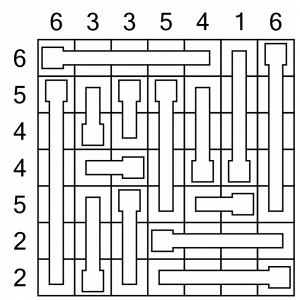
This is the grid we are starting with. As a level 2 it’s fairly small, and the thermometers only run horizontally and vertically. We’ll start off by looking for the easiest fills. Being a 7x7 grid, those 6s look promising.
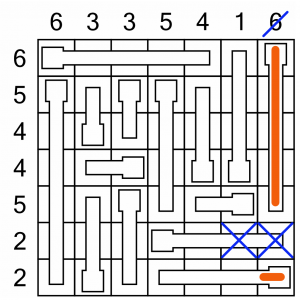
The final column is an easy win. Out of seven cells, six need to be filled. It’s easy enough to work out the one that cannot be filled – it’s in a row labelled 2, at the end of a thermometer four cells long. Obviously the end two cells of that thermometer can never be filled. To make life easier, we can cross them out. We know all the other cells in the column are filled. We can strike through the 6 at the top of the grid too, so we know we’ve done that column.
Let’s look at the first row, which is also a 6.
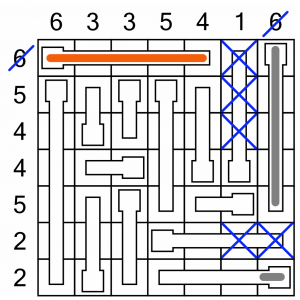
Because we’ve already got one cell filled in that row, we have to fill the whole of the other thermometer. We cannot possibly fill the cell in 1-column, because, well, that column can only contain one filled segment and that thermometer is four cells high! In fact, while we are at it, we will strike out the top three cells of that thermometer because we know they can never be filled. That row is done, so we can strike out its label, too.
Now we know how to complete the first column.
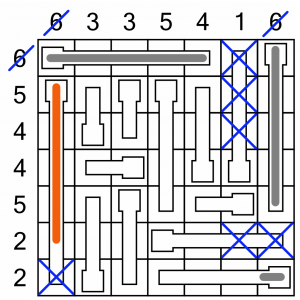
We can fill up the first five cells of the thermometer, reaching our target of 6. We strike out the bottom cell as it can’t be used, and strike out the label because that column is complete.
Now we’ve done the easy ones, let’s do some elimination. We’ll see if there’s anything we know we definitely cannot fill.
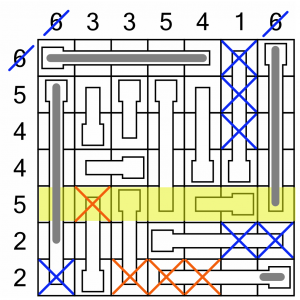
We can take out four more cells. Now, consider the row highlighted in yellow. We need to fill five cells, and have already filled two. There are four cells remaining. We know we’ll have to fill the bulbs of the two thermometers that start in that row, even if we don’t yet know where the fifth cell will be.
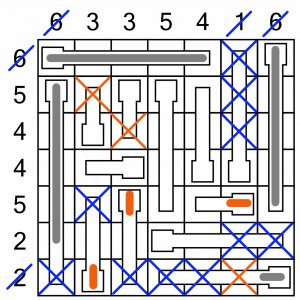
Putting those in completes the 1-column. Striking out the cell at the bottom of that column leaves us only one place to put our second cell in the 2-row (bottom row), so we can fill that in as well. These last placements have more knock-on effects: we can strike out cells in both the 3-columns because they are impossible to reach now.
Where next? Well, that second row (5) is looking promising.

We needed to fill three cells, and there were only three left. We’ve completed that row. We’ve also completed the 3-column, so we can cross out the last two cells in that one.
The cell we filled in the 4-column is useful, because it’s at the top of a thermometer. We must fill the cells below it.
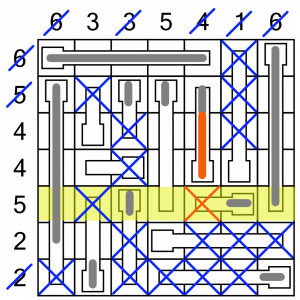
That’s completed the 4-column, so we cross out the remaining cell. That leaves us only one place to fill in the last cell in the 5-row highlighted...
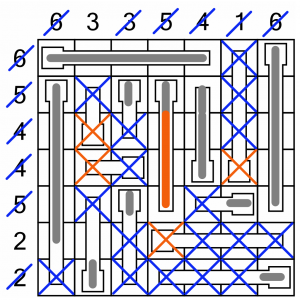
…and because that’s the top of a thermometer (even if it’s upside down), we have to fill the cells below it. That completes a whole bunch of columns and rows! In fact, we only have one cell left to fill in to complete the puzzle…
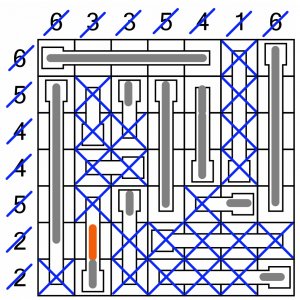
That last cell completes the remaining 2-row and 3-column. All done!
That was easy, wasn’t it? Of course it was, it was a level 2 puzzle! We publish seven levels of difficulty, with bigger grids, longer thermometers, and even thermometers that go around corners. Harder grids also have rows or columns without labels. Plenty to give your brain a proper workout. Read on to find out more.
Ready to have a go yourself? We’ve put together a taster of four puzzles for you, including the example above. You can download and print the PDF below. Solutions are included, but no cheating!
Download Our Thermometers Taster
Fancy filling some thermometers? We publish this puzzle occasionally in our free Puzzle Weekly magazine. You should totally sign up for that if you haven’t already, as it puts at least 28 brand new puzzles in your inbox every week.
You can also find lots of Thermometers puzzles in our Jumbo Adult Puzzle Book – which happens to include more than 500 puzzles of 20 different varieties.